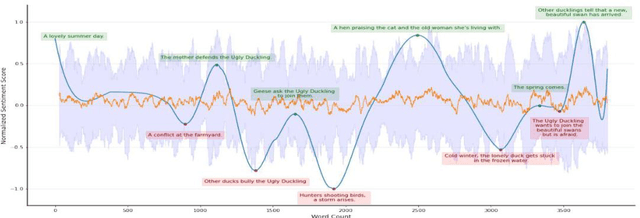Kristoffer Nielbo
Continuous sentiment scores for literary and multilingual contexts
Aug 20, 2025Abstract:Sentiment Analysis is widely used to quantify sentiment in text, but its application to literary texts poses unique challenges due to figurative language, stylistic ambiguity, as well as sentiment evocation strategies. Traditional dictionary-based tools often underperform, especially for low-resource languages, and transformer models, while promising, typically output coarse categorical labels that limit fine-grained analysis. We introduce a novel continuous sentiment scoring method based on concept vector projection, trained on multilingual literary data, which more effectively captures nuanced sentiment expressions across genres, languages, and historical periods. Our approach outperforms existing tools on English and Danish texts, producing sentiment scores whose distribution closely matches human ratings, enabling more accurate analysis and sentiment arc modeling in literature.
$S^3$ -- Semantic Signal Separation
Jun 18, 2024



Abstract:Topic models are useful tools for discovering latent semantic structures in large textual corpora. Topic modeling historically relied on bag-of-words representations of language. This approach makes models sensitive to the presence of stop words and noise, and does not utilize potentially useful contextual information. Recent efforts have been oriented at incorporating contextual neural representations in topic modeling and have been shown to outperform classical topic models. These approaches are, however, typically slow, volatile and still require preprocessing for optimal results. We present Semantic Signal Separation ($S^3$), a theory-driven topic modeling approach in neural embedding spaces. $S^3$ conceptualizes topics as independent axes of semantic space, and uncovers these with blind-source separation. Our approach provides the most diverse, highly coherent topics, requires no preprocessing, and is demonstrated to be the fastest contextually sensitive topic model to date. We offer an implementation of $S^3$, among other approaches, in the Turftopic Python package.
Good Books are Complex Matters: Gauging Complexity Profiles Across Diverse Categories of Perceived Literary Quality
Apr 14, 2024Abstract:In this study, we employ a classification approach to show that different categories of literary "quality" display unique linguistic profiles, leveraging a corpus that encompasses titles from the Norton Anthology, Penguin Classics series, and the Open Syllabus project, contrasted against contemporary bestsellers, Nobel prize winners and recipients of prestigious literary awards. Our analysis reveals that canonical and so called high-brow texts exhibit distinct textual features when compared to other quality categories such as bestsellers and popular titles as well as to control groups, likely responding to distinct (but not mutually exclusive) models of quality. We apply a classic machine learning approach, namely Random Forest, to distinguish quality novels from "control groups", achieving up to 77\% F1 scores in differentiating between the categories. We find that quality category tend to be easier to distinguish from control groups than from other quality categories, suggesting than literary quality features might be distinguishable but shared through quality proxies.
Danish Foundation Models
Nov 13, 2023

Abstract:Large language models, sometimes referred to as foundation models, have transformed multiple fields of research. However, smaller languages risk falling behind due to high training costs and small incentives for large companies to train these models. To combat this, the Danish Foundation Models project seeks to provide and maintain open, well-documented, and high-quality foundation models for the Danish language. This is achieved through broad cooperation with public and private institutions, to ensure high data quality and applicability of the trained models. We present the motivation of the project, the current status, and future perspectives.
Sentiment Dynamics of Success: Fractal Scaling of Story Arcs Predicts Reader Preferences
Dec 14, 2021



Abstract:We explore the correlation between the sentiment arcs of H. C. Andersen's fairy tales and their popularity, measured as their average score on the platform GoodReads. Specifically, we do not conceive a story's overall sentimental trend as predictive \textit{per se}, but we focus on its coherence and predictability over time as represented by the arc's Hurst exponent. We find that degrading Hurst values tend to imply degrading quality scores, while a Hurst exponent between .55 and .65 might indicate a "sweet spot" for literary appreciation.
DaCy: A Unified Framework for Danish NLP
Jul 12, 2021



Abstract:Danish natural language processing (NLP) has in recent years obtained considerable improvements with the addition of multiple new datasets and models. However, at present, there is no coherent framework for applying state-of-the-art models for Danish. We present DaCy: a unified framework for Danish NLP built on SpaCy. DaCy uses efficient multitask models which obtain state-of-the-art performance on named entity recognition, part-of-speech tagging, and dependency parsing. DaCy contains tools for easy integration of existing models such as for polarity, emotion, or subjectivity detection. In addition, we conduct a series of tests for biases and robustness of Danish NLP pipelines through augmentation of the test set of DaNE. DaCy large compares favorably and is especially robust to long input lengths and spelling variations and errors. All models except DaCy large display significant biases related to ethnicity while only Polyglot shows a significant gender bias. We argue that for languages with limited benchmark sets, data augmentation can be particularly useful for obtaining more realistic and fine-grained performance estimates. We provide a series of augmenters as a first step towards a more thorough evaluation of language models for low and medium resource languages and encourage further development.
 Add to Chrome
Add to Chrome Add to Firefox
Add to Firefox Add to Edge
Add to Edge